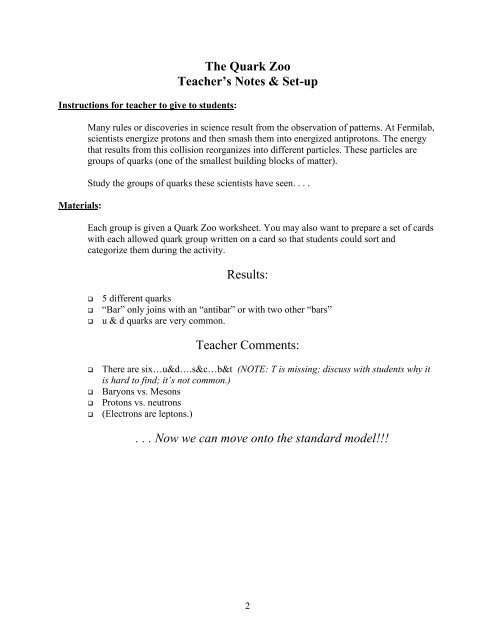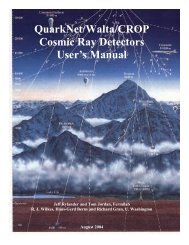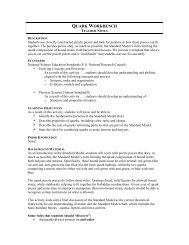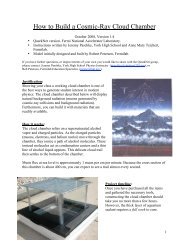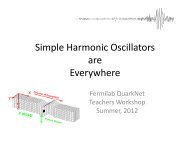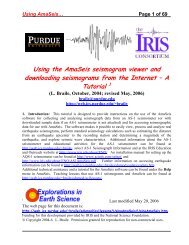- Page 1 and 2: Materials for Teaching Modern Physi
- Page 3 and 4: Which activities did you use in you
- Page 5 and 6: Materials for Teaching Modern Physi
- Page 7 and 8: QuarkNet is a nationwide program th
- Page 9 and 10: Radioactivity PowerPoint Presentati
- Page 11 and 12: Problems & Worksheets * This activi
- Page 13: The Cloud Chamber: In the Nobel Pri
- Page 18 and 19: Teacher’s Key Constant Velocity P
- Page 20: Sample Problem: Free Fall and Proje
- Page 23 and 24: 3. Cindy drops a cherry pit out the
- Page 25 and 26: 2. Running at 2 m/s, Chris, the 50-
- Page 27 and 28: 3. A 55-kg swimmer is standing on a
- Page 29 and 30: Analysis to prove that momentum was
- Page 32 and 33: Teacher’s Key Circular Motion Pro
- Page 34 and 35: Student Worksheet Constant Accelera
- Page 36 and 37: Teacher’s Key Constant Accelerati
- Page 38: The Electron 1. What is the value o
- Page 41 and 42: 5. A negatively charged oil drop we
- Page 44 and 45: The History of the Electron Workshe
- Page 46 and 47: Student Worksheet Motion of Charged
- Page 48: Particle Quiz 2 Answer each questio
- Page 51 and 52: . What is the direction of the magn
- Page 53 and 54: High V The Three Experiments in One
- Page 55 and 56: For path B… The cathode ray inter
- Page 57 and 58: In his experiment, Millikan tried t
- Page 60 and 61: Notes on the Electron PowerPoint Pr
- Page 62 and 63: Student Worksheet Index of Refracti
- Page 64 and 65:
Teacher’s Key Index of Refraction
- Page 66 and 67:
4. A common particle detector techn
- Page 68 and 69:
Student Worksheet WARP SPEED Step 1
- Page 70 and 71:
Step 1. Select Race for Energy and
- Page 72 and 73:
Step 1. Select Law ‘n Order. Step
- Page 74:
Teacher’s Notes The Half-Life of
- Page 77 and 78:
a. What do the graphs of the class
- Page 79 and 80:
Time (min) 1 2 3 4 5 6 7 8 9 10 11
- Page 82 and 83:
1. What is half-life? Half-Life Pra
- Page 84 and 85:
Radioactivity The emission of alpha
- Page 86 and 87:
Beta Particle • An electron emitt
- Page 88:
Penetrating Power Radioactive Sourc
- Page 91 and 92:
. How far does the muon travel, as
- Page 93 and 94:
4a. Can a person, in principle, tra
- Page 95 and 96:
4. In a high-energy collision betwe
- Page 98 and 99:
Modern Physics The Ultraviolet Cata
- Page 100 and 101:
By the way, the y-axis of these gra
- Page 102 and 103:
5. OK, so that’s real data from r
- Page 104:
. Sketch a graph of this equation:
- Page 107 and 108:
4. Calculate the wavelength of the
- Page 109 and 110:
5. An air rifle is used to shoot 1-
- Page 111 and 112:
4. The work function for potassium
- Page 113 and 114:
100
- Page 115 and 116:
102
- Page 117 and 118:
6. Describe the quantum-mechanical
- Page 119 and 120:
106
- Page 121 and 122:
Draw Geiger, Marsden, and Rutherfor
- Page 123 and 124:
Explain why Balmer/Rydbergh’s for
- Page 125 and 126:
112
- Page 127 and 128:
10. Describe how particle physics a
- Page 129 and 130:
Particle Acceleration (Principles)
- Page 131 and 132:
Electric Field and Acceleration +
- Page 133 and 134:
Multistage Accelerators (LINAC) 1 2
- Page 135 and 136:
Particle Accelerators Why were they
- Page 137 and 138:
Cyclotrons are constructed as two
- Page 139 and 140:
126
- Page 141 and 142:
QUIZ ON PARTICLE ACCELERATORS 1. De
- Page 143 and 144:
130
- Page 145 and 146:
There are 12 elementary particles t
- Page 147 and 148:
134
- Page 149 and 150:
136
- Page 151 and 152:
6. What magnetic field intensity is
- Page 153 and 154:
And finally, we need to remember sp
- Page 155 and 156:
Z Boson Mass Reconstruction for DØ
- Page 157 and 158:
1 Z Boson Mass Reconstruction for D
- Page 159 and 160:
1 Z Boson Mass Reconstruction for D
- Page 161 and 162:
3D Z Boson Mass Reconstruction Answ
- Page 163 and 164:
150
- Page 165 and 166:
7. J. J. Thompson applied a net for
- Page 167 and 168:
d.) energy / a silicon detector and
- Page 169 and 170:
1) A 2) E 3) E 4) B 5) B 6) B 7) C
- Page 171 and 172:
16. What are the three particles th
- Page 173 and 174:
16. What are the three particles th
- Page 175 and 176:
Anticharm ( c ) Antimatter Quark Ch
- Page 177 and 178:
Gluon Gauge boson Force carrier: St
- Page 179 and 180:
3. -1 charge 4. Positron 4. Antimuo
- Page 181 and 182:
Standard Model Review - Answer Key
- Page 183 and 184:
5. Now draw the p vectors of p + an
- Page 185 and 186:
172
- Page 187 and 188:
5. Now draw the p vectors of p + an
- Page 189 and 190:
176
- Page 191 and 192:
Newton’s Universal Law of Gravita
- Page 193 and 194:
II. Intended Activities and Approxi
- Page 195 and 196:
All questions from project written
- Page 197 and 198:
periodicals and newsletters. The co
- Page 199 and 200:
Fermilab’s Accelerators This is a
- Page 201 and 202:
188
- Page 203 and 204:
190
- Page 205 and 206:
A Game for Building a Detector http
- Page 207 and 208:
194
- Page 209 and 210:
us. An alternate “radiation” so
- Page 211 and 212:
198
- Page 213 and 214:
Day 4: 1. Question of the Day: A ha
- Page 215 and 216:
Teacher Resources: 1. Standard Mode
- Page 217:
204


